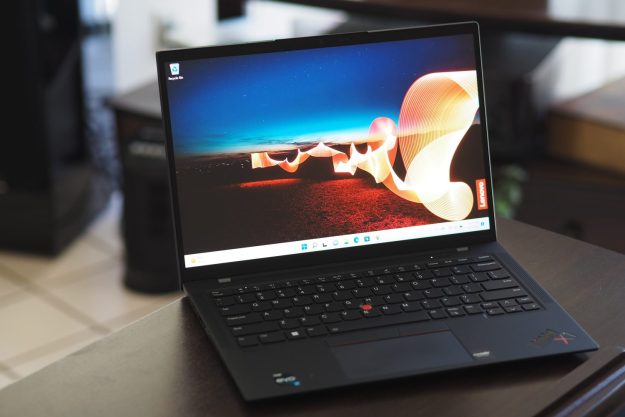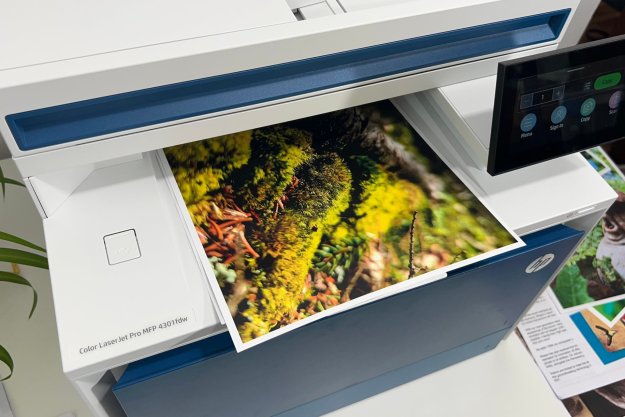- Solid performance; feature-rich; excellent cooling
- Case design is hit or miss; loud at times
- could be quieter
Summary
The Alienware Area-51 7500 desktop PC packs quite a punch, even when it’s not stocked to the gills with every high-end option offered. Our test system represents a good balance between price and performance, making it a good pick for anyone looking to buy a new system. Read on to find out how the new P2 enclosure with Core 2 Duo water cooled system stacks up.

The front door opens to reveal the DVD writer and open bays

Alienware Area-51 7500 in Grey
Setup and Testing
Alienware bundles two interesting applications with all their systems. The first is a limited version of ObjectDock dubbed AlienGUIse, which changes the appearance of the windows interface. Everything from window borders and fonts, to wallpapers, icons, and sound schemes can be changed. This version only allows switching between the default Alienware themes, which, while nice, add processor overhead and waste screen space. Uninstalling this was easy and resulted in no system problems. The second application is the AlienFX controller, which allows the user to customize the case’s lighting scheme. There are 24 colors to choose from and each of the five zones can use any color. Themes can be saved, and loaded later. We expect more enhancements to be one the way, as the “Advanced” mode is disabled and inaccessible, and the theme idea just wreaks of custom themes for different applications. One small bug we found involved the AlienFX lighting software. The software reports a time out in some cases when then system restarts without power down completely. Closing and reopening the application seems to take care of it, though.
Alienware AlienFX control Panel
Our system was configured exactly as we ordered it, and we had only one minor issue out of the box. The installed Nvidia drivers officially supported by Alienware were a couple versions behind the Forceware version. This wouldn’t have been a big issue, if only for the fact that the shipped drivers did not allow the video card to be taken out of SLI mode, as they did not support Nvidia’s new control panel application. This is required in order to drive more than one monitor, and our dual monitor setup wasn’t going to be put to waste due to a driver issue. We installed the official Forceware drivers and installed them. Upon rebooting, any attempt to open the Nvidia control panel resulted in the control panel crashing before it was even visible. In desperation, we uninstalled and reinstalled the driver in Safe Mode, rebooting between each step. This worked like a charm, and we’ve had no other configuration issues to speak of.
So is it fast? We ran 3DMark03, 3DMark05, 3DMark06, and SiSoft’s Sandra. Here’s what we got:
|
Test
|
Score
|
|
3DMark03
|
32578
|
|
3DMark05
|
14317
|
|
3DMark06
|
8268
|
|
SM2.0
|
3675
|
|
HDR/SM3.0
|
3520
|
|
CPU
|
2269
|
|
Sandra Dhrystone
|
24412
|
|
Sandra Whetstone
|
16930
|
|
Sandra Integer
|
145858
|
|
Sandra Float
|
79042
|
These are some impressive numbers. We ran all tests using the default values on a single monitor with SLI enabled. In real world performance, we have been running FEAR, Battlefield 2, and City of Villains at 1600×1200 with most sliders at maximum values, and we still maintain playable frame rates. We should also point out again that this system is not the highest end you can configure, but represents a second tier gaming system from the venerable PC maker. Needless to say, we were very pleased with the performance.

Enough lights for you?
Conclusion
Simply put, the Alienware Area-51 7500 is an excellent all around PC worthy of serious attention. While a similarly spec’ed self built rig will run approximately $400 cheaper, it’s impossible to ignore the craftsmanship of the internal wiring, the unique bells and whistles, the fine configuration job, and the ease of a single source for support issues, should you ever have any. When the dust has settles, you will welcome our uber-gaming rig overlords, and their glowing eyes of pwnage.
Pros:
• Impress performance
• Very feature-rich
• Excellent cooling system
Cons:
• Case can be gaudy looking to some
• Fairly loud, could be quieter
Editors' Recommendations
- Best gaming laptop deals: Alienware, Razer, Asus and more
- 9 best laptops of 2024: tested and reviewed
- 10 best desktop computers of 2024: tested and reviewed
- 9 best 2-in-1 laptops in 2024: tested and reviewed
- 9 best processors for PC gaming: tested and reviewed




